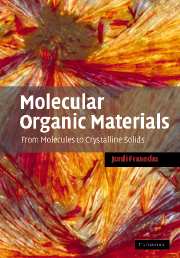Book contents
- Frontmatter
- Contents
- Preface
- List of abbreviations and symbols
- List of chemical abbreviations
- 1 An introduction to molecular organic materials
- 2 Building molecules: molecular engineering
- 3 Building materials: crystal engineering
- 4 Interfaces
- 5 Thin-film growth: from 2D to 3D character
- 6 A miscellany of physical properties
- Afterword
- Appendix A
- Appendix B
- References
- Index
6 - A miscellany of physical properties
Published online by Cambridge University Press: 23 November 2009
- Frontmatter
- Contents
- Preface
- List of abbreviations and symbols
- List of chemical abbreviations
- 1 An introduction to molecular organic materials
- 2 Building molecules: molecular engineering
- 3 Building materials: crystal engineering
- 4 Interfaces
- 5 Thin-film growth: from 2D to 3D character
- 6 A miscellany of physical properties
- Afterword
- Appendix A
- Appendix B
- References
- Index
Summary
Forget it! Forget it! Everything I write is just so much bleating!
Gary Larson, Last Chapter and WorseAfter having discussed many aspects related to MOMs in the previous chapters, from the synthesis of the building blocks, the molecules, to the assembling of such molecules in the solid state in the form of single crystals and thin films, this last chapter is devoted to the physical properties of MOMs based on selected examples. The reader should be aware that this selection, being personal and thus inevitably partial, does not cover the plethora of examples that can be found in the literature. I assume the risk of overlooking some important works. In order to apologize in advance for not including several important investigations I reproduce the wise comment from M. Faraday written in 1859 but of surprising actuality (Faraday, 1859):
I very fully join in the regret…that scientific men do not know more perfectly what has been done, or what their companions are doing; but I am afraid the misfortune is inevitable. It is certainly impossible for any person who wishes to devote a portion of his time to chemical experiment, to read all the books and papers that are published in connection with his pursuit; their number is immense, and the labour of winnowing out the few experimental and theoretical truths which in many of them are embarrassed by a very large proportion of uninteresting matter, of imagination, and of error, is such, that most persons who try the experiment are quickly induced to make a selection in their reading, and thus inadvertently, at times, pass by what is really good.
- Type
- Chapter
- Information
- Molecular Organic MaterialsFrom Molecules to Crystalline Solids, pp. 242 - 306Publisher: Cambridge University PressPrint publication year: 2006

